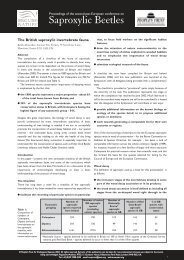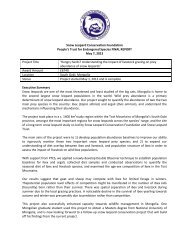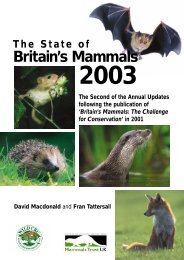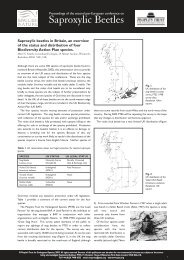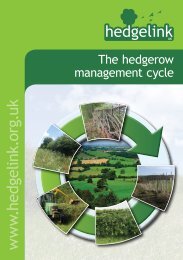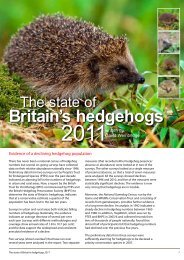published paper - People's Trust for Endangered Species
published paper - People's Trust for Endangered Species
published paper - People's Trust for Endangered Species
Create successful ePaper yourself
Turn your PDF publications into a flip-book with our unique Google optimized e-Paper software.
G ModelMAMBIO-40531; No. of Pages 7ARTICLE IN PRESS4 D. O’Mahony et al. / Mammalian Biology xxx (2012) xxx–xxxFig. 2. Distribution of pine marten in 10 km grid squares in the Republic of Ireland during 1978–1980 (O’Sullivan 1983) (a) and from a re-survey in 2005–2006 (b). Totalsample size of 10 km national grid squares available <strong>for</strong> comparison n = 183.Changes in pine marten distributionThe occupancy rate of comparable grid squares in 1978–1980was 28.4% and in 2005–2006 was 63.9% (Fig. 2), suggesting that arange expansion of pine marten had occurred. Seventy-two 10 kmgrid squares changed status between surveys with 68 (94%) changingfrom non-detected to detected status and the remaining 4 (6%)changing from detected to non-detected.The number of 10 km grid squares where pine marten weredetected between surveys had increased by 65, a statistically significantchange (McNemar Test: 2 = 34.3, df = 1, P < 0.001). Changes inoccupancy status occurred throughout the Republic of Ireland, butwere mainly concentrated in the midlands, southeast, southwestand east (Fig. 2).Using the criteria specified estimated mean pine marten abundancein the Republic of Ireland was 2740 individuals with apopulation of 320 pine marten estimated <strong>for</strong> Northern Ireland(Table 2).Core-range and population abundanceAn indicative current core population range <strong>for</strong> pine marten <strong>for</strong>each jurisdiction was determined (Table 1). Within this range 13510 km grid squares were surveyed (approx. survey coverage 35%)and pine marten were detected in 122 (90.4%) and non-detected in13 (9.6%).It was estimated that over 50% of the land area of the Republicof Ireland constituted core-range <strong>for</strong> the species whilst a smallerland area in Northern Ireland (18.3%) was considered pine martencore range (Table 1, Fig. 3). At the island of Ireland scale, 45.9% ofthe land area was estimated to be core population range <strong>for</strong> pinemarten.Table 1Assessment of indicative core population range <strong>for</strong> pine marten on the island ofIreland.Jurisdiction Territorial landarea (km 2 )Estimated corerange (km 2 )Percentageland-area (%)Republic of Ireland 69,831 35,975 51.5Northern Ireland 14,148 2588 18.3All-Ireland 83,979 38,563 45.9Fig. 3. Estimated pine marten core-population range (90% occupancy) in the Republicof Ireland and Northern Ireland.Please cite this article in press as: O’Mahony, D., et al., Pine marten (Martes martes) distribution and abundancein Ireland: A cross-jurisdictional analysis using non-invasive genetic survey techniques. Mammal. Biol. (2012),http://dx.doi.org/10.1016/j.mambio.2012.04.001
G ModelMAMBIO-40531; No. of Pages 7ARTICLE IN PRESSD. O’Mahony et al. / Mammalian Biology xxx (2012) xxx–xxx 5Table 2Estimated population abundance of pine marten at a jurisdictional level on the island of Ireland based on current distribution, occupied habitat and mean territory size.Confidence intervals generated by bootstrapping techniques.Jurisdiction Habitat availability(km 2 )Estimated habitat areaoccupied (km 2 )AbundanceestimateConfidenceintervals (90%)Republic of Ireland 7090 4225 2740 1350–4330Northern Ireland 880 499 320 160–510DiscussionCurrent distribution and changeAt the Island of Ireland level, pine marten distribution was concentratedin the west and midlands of the Republic of Ireland,with more fragmented and isolated populations in the southwest,southeast and east. Pine marten were detected in areas wherethey had been historically absent and their current distributionmay represent the most widespread <strong>for</strong> the species at any pointin the last 50 years. However, given that the population had undergonesubstantial declines in the preceding decades and centuriesthe importance of this should not be overstated. There remainlarge regions where the species had historically occurred that containedsuitable habitat but pine marten were non-detected. Thiswas particularly the case in the south and southeast of the Republicof Ireland and throughout a large part of Northern Ireland.There<strong>for</strong>e, in terms of the historical context, current pine martendistribution remains significantly diminished across the island ofIreland.In the Republic of Ireland, pine marten range had apparentlyincreased over the last 30 years. This has probably occurred byexpansion from refuge areas in the west and other relict populationsidentified by O’Sullivan (1983). The expansion of populationrange <strong>for</strong> Martes species have recently been reported in other countriesand has been attributed to natural dispersion (Balestrieriet al. 2010), reduced hunting or persecution (Ozolinš and Pilats1995) and through deliberate re-introductions (Aubry and Lewis2003).In the Republic of Ireland there are at least 3 important factorsthat could have influenced the range expansion found in the currentstudy. Firstly, since the 1980s there has been a large increase inthe land area covered by <strong>for</strong>estry from an estimated 390,000 ha in1980, to 709,000 ha currently (10% of the country area; DAFF (2008).The increased <strong>for</strong>est cover provided greater habitat availability andconnectivity, which may have assisted in natural range expansionof pine marten.The second factor that may have contributed to the increase inpine marten distribution in the Republic of Ireland was the legalprotection af<strong>for</strong>ded the species under the Wildlife Act (1976). Priorto statutory protection, direct hunting of pine marten <strong>for</strong> their fur,persecution as a perceived pest species and general predator controlprograms that utilised poisoned baits and snares contributed tothe decline in pine marten distribution (O’Sullivan 1983). Increasesin the distribution of pine marten following reduced persecutionand/or hunting pressure have been recorded in other parts of theirrange (Ozolinš and Pilats, 1995).The third factor that has likely influenced the current distributionof pine marten in the Republic of Ireland is deliberatere-introductions into regions where they were historically presentbut had become locally extirpated. The best known re-introductionoccurred in Killarney National Park (52 ◦ 02 ′ 12N 9 ◦ 32 ′ 04W) duringthe late 1980s to the mid 1990s when up to 30 individuals weresourced from the west of Ireland and released into the park (P.O’Sullivan, pers. comm.). This release may have accounted <strong>for</strong> theincreased distribution of the species in the southwest of the Republicof Ireland as determined by the current survey. It is uncertain ifother re-introductions or deliberate releases of pine marten haveoccurred or to what extent they may have contributed to rangeexpansion. State conservation agencies do relocate pine martenwhere they come into conflict with people (e.g. occupy households)but there is little in<strong>for</strong>mation available on the numbers of individualsinvolved or the areas from which and to which they arerelocated. Potentially this could have been an important mechanisminfluencing range expansion at a local or regional scale andrequires further investigation.Other possible contributory factors to the range expansion ofpine marten in the Republic of Ireland could have included reducedinter-specific competition and intra-guild predation due to changesin the abundance or dynamics of the red fox (Vulpes vulpes) themain potential competitor of pine marten in Ireland and evenmesopredator release. Data are not available on fox populationsor dynamics to this hypothesis. Studies have shown that predationby red foxes has the potential to impact on pine marten populations(Lindström et al. 1995). On the island of Ireland foxes are relativelycommon and occupy a range of habitats including <strong>for</strong>estry. Pinemarten have had to adapt a highly fragmented <strong>for</strong>est landscapeover recent centuries and the potential impact of species such asred fox is uncertain.It is important to emphasise that the apparent range expansionof pine martens in the Republic of Ireland has occurred inthe absence of any direct or co-ordinated conservation action orintervention <strong>for</strong> the species. Even though it was known in the1970s that the population had been substantially reduced andextirpated throughout most of the country, statutory agencies didnot act to produce any direct management or policy initiatives topromote the conservation of the species, relying on legal protectiononly. Af<strong>for</strong>estation, one of the factors that may have assistedin pine marten range expansion, was enacted primarily <strong>for</strong> economicand social motives rather than wildlife conservation perse.In Northern Ireland, there was little or no evidence of anyrange expansion by pine martens over recent decades. The populationremains largely concentrated in western areas where ithas been established <strong>for</strong> decades (Hughes 1993; Fairley 2001). Inthe remainder of Northern Ireland pine marten are largely extirpated.Where the species does occur, it occurs in fragmented andisolated populations, which are susceptible to stochastic eventsthat may impact on short to medium term population viability(Shaffer 1981). Over the last 30 years legal protection hasbeen af<strong>for</strong>ded pine marten in Northern Ireland (Wildlife OrderNI 1986) and there has also been an increase in <strong>for</strong>est landcover from 6700 ha in 1980 to 8800 ha (6.5% land area) by 2010(FS 2010). The apparent lack of any or limited range expansionis a cause of concern and suggests that barriers may exist,preventing re-colonisation of <strong>for</strong>mer historical range. Potentialimportant factors could include small population size, habitatfragmentation, poor dispersal survival rates and illegal persecution.Understanding potential barriers to range expansion fromwestern core population range and the extent and viability of fragmentedpine marten populations in Northern Ireland is critical tofuture conservation management of the species. This is particularlyurgent given that abundance estimates in the low hundredsPlease cite this article in press as: O’Mahony, D., et al., Pine marten (Martes martes) distribution and abundancein Ireland: A cross-jurisdictional analysis using non-invasive genetic survey techniques. Mammal. Biol. (2012),http://dx.doi.org/10.1016/j.mambio.2012.04.001
G ModelMAMBIO-40531; No. of Pages 7ARTICLE IN PRESS6 D. O’Mahony et al. / Mammalian Biology xxx (2012) xxx–xxxput the population in Northern Ireland a magnitude below thatin Scotland (c. 3500 individuals) and closer to population statusin England and Wales (c. 120 individuals) in the wider UK context(Harris et al. 1995). The current absence of a conservationstrategy <strong>for</strong> the species in Northern Ireland needs to be immediatelyaddressed.Conservation and managementThe range expansion of pine marten in the Republic of Irelandis important in terms of species conservation but may increasinglypresent management dilemmas. Pine marten are highlyefficient predators and can impact on other wildlife species, particularlyavifauna (Sonerud 1985; Summers et al. 2009; Pöysäet al. 1997; Wegge and Kastdalen 2007). The re-occupation ofhistoric range could bring the species into conflict with managementinterests of other species. Where this occurs, site specificand integrated management plans should be instigated that explicitlyacknowledge that some level of predation is naturally partof a stable predator–prey system, especially where rare, nativearboreal predators are concerned. There is also the potential <strong>for</strong>human–wildlife conflict particularly in relation to game rearing andlivestock interests that may lead to increased rates of illegal persecution,which could cause future local extirpations or even rangecontraction of pine marten.The largest habitat resource <strong>for</strong> the species is dynamic, shortrotation (e.g. 50–60 years) commercial <strong>for</strong>estry plantation. Thereis little understanding of the sustainability of this habitat <strong>for</strong> pinemarten, the impact of <strong>for</strong>est management practices such as timberharvesting on their ecology or how the population may respond tocurrent and future af<strong>for</strong>estation policy in both jurisdictions whichpromotes small-scale private plantations (i.e. extensive habitatfragmentation) as opposed to large-scale <strong>for</strong>estry development. Fora species with a small population size and low reproductive ratethat is very susceptible to human interference these factors havethe potential to significantly impact on the pine marten populationinto the future.Our results may necessitate the re-evaluation of recent jurisdictionalconservation assessments <strong>for</strong> the species that suggest thepine marten is of favourable conservation status and of least concernin terms of red list status, as they were partly based on whatappear to be considerable overestimates of population abundance(3000–10,000 individuals, Marnell et al. (2009)), as compared toless than 3000 in the current study. Given the general lack of dataon pine marten ecology and the deficient understanding of howimportant the Irish population may be in the European context are-assessment appears prudent. The recent finding of a potentiallyunique “Irish” haplotype with reference to British populations alsosupports this (Jordan 2011).In terms of species conservation, statutory agencies in eachjurisdiction should develop and implement conservation strategiesand management objectives <strong>for</strong> pine marten. These shouldensure the sustainability of any recent range expansion, that possiblefuture expansion is supported and potential conflict scenarioscan be identified and mitigated against to limit the potential <strong>for</strong>increased illegal persecution.There is also a critical need <strong>for</strong> studies on the most basic aspectsof pine marten ecology, particularly population abundance, sociospatialecology, habitat selection, productivity, survival and anyimpacts of <strong>for</strong>est management on the species. Regular monitoringand surveillance of pine marten is a fundamental requirementdue to international obligations (i.e. Bern Convention and HabitatsDirective) and also national commitments in respective jurisdictionswith respect to biodiversity conservation but may be limiteddue to insufficient funding availability.AcknowledgementsFunding <strong>for</strong> this project was provided by the Forest Service ofthe Department of Agriculture and Food, Ireland under the NationalDevelopment Plan 2000–2006, Heritage Council under the WildlifeGrants Scheme 2005, the Peoples <strong>Trust</strong> <strong>for</strong> <strong>Endangered</strong> <strong>Species</strong> (UK)and the National Parks and Wildlife Service of the Department ofEnvironment, Heritage and Local Government.Staff at Coillte Teoranta Ltd. provided considerable logisticalsupport to the project including the availability of GIS databases,access to their <strong>for</strong>est estate and field staff in the Republic of Ireland.The Forest Service of Northern Ireland provided an activity permitto work on Forest Service lands in Northern Ireland and access to aGIS inventory of the <strong>for</strong>est estate.We would like to thank the following individuals who completedtransect based surveys: Dr Pól Mac Cana, David O’ Neill, PaulaHarkness, Joe McDonnell, Richard Brown, Michael McNamara andDan Byrne.Dr. Pól Mac Cana and two anonymous referees provided valuablecomments on the manuscript and we sincerely appreciate theirtime and input.ReferencesAubry, K.B., Lewis, J.C., 2003. Extirpation and reintroduction of fishers (Martes pennanti)in Oregon: implications <strong>for</strong> their conservation in the Pacific states. Biol.Conserv. 114, 79–90.Austin, M.P., 2002. Spatial prediction of species distribution: an interface betweenecological theory and statistical modelling. Ecol. Model. 157, 101–118.Balestrieri, A., Ruiz-González, A., Remonti, L., Gómez-Moliner, B.J., Genovese, S., Gola,L., Prigioni, C., 2008. A non-invasive genetic survey of the pine marten (Martesmartes) in the western River Po plain (Italy): preliminary results Hystrix It. J.Mamm. 19, 77–80.Balestrieri, A., Remonti, L., Ruiz-González, A., Gómez-Moliner, B.J., Vergara, M., Prigioni,C., 2010. Range expansion of the pine marten (Martes martes) in anagricultural landscape matrix (NW Italy). Mamm. Biol. 75, 412–419.Balharry, E.A., McGowan, G.M., Kruuk, H., Halliwel, E., 1996. Distribution of PineMartens in Scotland as Determined by Field Survey and Questionnaire. SNHSurvey and Monitoring Report No. 48. Scottish Natural Heritage, Edinburgh, UK.Barka, I., 2005. Winter distribution of European pine marten (Martes martes) scatsin a protected area of Galicia, Spain. Mammalia 69, 435–438.Birks, J.D.S., Messenger, J.E., Braithwaite, A.C., Davison, A., Brookes, R.C., Strachan,C., 2004. Are scat surveys a reliable method <strong>for</strong> assessing distribution and populationstatus of pine martens? In: Harrison, D.J., Fuller, A.K., Proulx, G. (Eds.),Martens and Fishers (Martes) in Human-altered Environments: An InternationalPerspective. Springer, New York, pp. 235–252.Bright, P.W., Harris, S., 1994. Reintroduction of the pine marten: feasibility study.Engl. Nat. Contract Rep.Buckland, S.T., Elston, D.A., 1993. Empirical models <strong>for</strong> the spatial distribution ofwildlife. J. Appl. Ecol. 30, 478–495.Buskirk, S.W., 1992. Conserving circumboreal <strong>for</strong>ests <strong>for</strong> martens and fishers. Conserv.Biol. 6, 318–320.Carroll, C., Zielinski, W.J., Noss, R.F., 1999. Using presence-absence data to build andtest spatial habitat models <strong>for</strong> the fisher in the Klamath region. USA Conserv.Biol. 13, 1344–1359.Clevenger, A.P., 1993. The European Pine Marten Martes martes in the BalearicIslands, Spain. Mamm. Rev. 23, 65–72.DAFF, 2008. Irish Forests—A Brief History. Department of Agriculture, Food andForestry, Dublin, Ireland.Davison, A., Birks, J.D.S., Brookes, R.C., Braithwaite, A.C., Messenger, J.E., 2002. Onthe origin of faeces: morphological versus molecular methods <strong>for</strong> surveying rarecarnivores from their scats. J. Zool. 257, 141–143.Deane, C.D., 1952. Pine marten in counties Tyrone and Down. Ir. Nat. J. 10, 303.EPA, 2006. Environment in Focus 2006: Environmental Indicators <strong>for</strong> Ireland. EnvironmentalProtection Agency, Ireland.Erb, J., 2008. Distribution and Abundance of Wolves in Minnesota 2007–2008. MinnesotaDepartment of Natural Resources, Grand Rapids, MN.Fairley, J., 2001. A Basketful of Weasels. Privately Published, Belfast, NorthernIreland.Field, S., Tyre, A., Possingham, H., 2005. Optimizing allocation of monitoring ef<strong>for</strong>tunder economic and observational constraints. J. Wildl. Manage. 69, 473–482.FS, 2010. Forest Statistics 2010: Woodland Areas and Planting. Forest Commission,Britain.Harris, S., Morris, P., Wray, S., Yalden, D., 1995. A Review of British Mammals:Population Estimates and Conservation Status of British Mammals Other thanCetaceans. Joint Nature Conservation Committee, Peterborough.Helldin, J.-O., 2000. Population trends and harvest management of pine marten(Martes martes) in Scandinavia. Wildl. Biol. 6, 111–120.Please cite this article in press as: O’Mahony, D., et al., Pine marten (Martes martes) distribution and abundancein Ireland: A cross-jurisdictional analysis using non-invasive genetic survey techniques. Mammal. Biol. (2012),http://dx.doi.org/10.1016/j.mambio.2012.04.001
G ModelMAMBIO-40531; No. of Pages 7ARTICLE IN PRESSD. O’Mahony et al. / Mammalian Biology xxx (2012) xxx–xxx 7Hughes, D., 1993. Mammal Survey of Five <strong>Species</strong>: Red Squirrel, Grey Squirrel, PineMarten, Irish Hare and English Hare. Ulster Wildlife <strong>Trust</strong> and Forest ServiceDANI, Crossgar, Northern Ireland.Jordan, N.R., 2011. A Strategy <strong>for</strong> Restoring the Pine Marten to England and Wales.Vincent Wildlife <strong>Trust</strong>.Kindberg, J., Swenson, H.E., Ericsson, G., Bellemain, E., Miquel, C., Pierre, T., 2011.Estimating population size and trends of the Swedish brown bear (Ursus arctos)population. Wildl. Biol. 17, 114–123.King, A.L.K., 1952. Pine marten in Co. Roscommon. Ir. Nat. J. 10, 321.Kocher, T.D., Thomas, W.K., Meyer, A., Edwards, S.V., Pääbo, S., Villablanca, F.X.,Wilson, A.C., 1989. Dynamics of mitochondrial DNA evolution in animals: amplificationand sequencing with conserved primers. Proc. Natl. Acad. Sci. U.S.A. 86,6196–6200.Lindström, E.R., Brainerd, S.M., Helldin, J.O., Overskaug, K., 1995. Pine martenredfox interactions: a case of intraguild predation? Ann. Zool. Fennici. 32,123–130.Lockie, J.D., 1964. Distribution and fluctuation of pine marten Martes Martes (L.) inScotland. J. Anim. Ecol. 33, 349–356.Ma, Y., Xu, L., 1994. Distribution and conservation of sables in China. In: Buskirk,S.W., Harestad, A.S., Raphael, M.G., Powell, R.A. (Eds.), Martens, Sables, and Fishers:Biology and Conservation. Cornell University Press, Ithaca, New York, pp.255–261.Mackenzie, D.I., Nichols, J.D., Hines, J.E., Knutson, M.G., Franklin, A.B., 2003. Estimatingsite occupancy, colonization, and local extinction when a species is detectedimperfectly. Ecology 84, 2200–2207.Mackenzie, D.L., Royle, J.A., 2005. Designing occupancy surveys: general advice andallocating survey ef<strong>for</strong>t. J. Appl. Ecol. 42, 1105–1114.Manly, B.F.J., 1997. Randomization, Bootstrap and Monte Carlo Methods in Biology,second ed. Chapman and Hall, London.Manley, P.N., Schlesinger, M.D., Roth, J.K., Horne van, B., 2005. A field basedevaluation of presence–absence protocol <strong>for</strong> monitoring ecoregional-scale biodiversity.J. Wildl. Manage. 69, 950–966.Marnell, F., Kingston, N., Looney, D., 2009. Ireland Red List No. 3: Terrestrial Mammals.National Parks and Wildlife Service, Department of the Environment,Heritage and Local Government, Dublin, Ireland.Mowat, G., Paetkau, D., 2002. Estimating marten Martes americana population sizeusing hair capture and genetic tagging. Wildl. Biol. 8, 201–209.Moriarty, C., 1961. Pine marten, Martes martes (L.), in Co. Wicklow. Ir. Nat. J. 13, 239.Mullins, J., Statham, M.J., Roche, T., Turner, P.D., O’Reilly, C., 2010. Remotely pluckedhair genotyping: a reliable and non-invasive method <strong>for</strong> censusing pine marten(Martes martes L. 1758) populations. Eur. J. Wildl. Res. 56, 443–453.Murray, J.V., Low Choy, S., McAlpine, C.A., Possingham, H.P., Goldizen, A.W., 2008.The importance of ecological scale <strong>for</strong> wildlife conservation in naturally fragmentedenvironments: a case study of the brush-tailed rock-wallaby (Petrogalepenicillata). Biol. Conserv. 141, 7–22.O’Mahony, D., 2009. Pine marten (Martes martes) socio-spatial ecology and habitatselection in upland coniferous <strong>for</strong>ests. Report to the Forest Service of theDepartment of Agriculture, Fisheries and Food (Ireland) and MTUK.O’Reilly, C., Statham, M., Mullins, J., Turner, P.D., O’ Mahony, D., 2008. Efficient speciesidentification of pine marten (Martes martes) and red fox (Vulpes vulpes) scatsusing a 5¢ nuclease real-time PCR assay. Conserv. Genet. 9, 735–738.O’Sullivan, P.J., 1983. The distribution of Pine Marten (Martes martes) in the Republicof Ireland. Mamm. Rev. 13, 39–44.Ozolinš, J., Pilats, V., 1995. Distribution and status of small and medium-sized carnivoresin Latvia. Ann. Zoo. Fenni. 32, 21–29.Pertoldi, C., Madsen, A.B., Barker, S.F., Jørgensen, H., Randi, E., Muñoz, J., Baagoe, H.,Loeschcke, V., 2008. Spatio-temporal population genetic survey of the Danishpine marten (Martes martes). Biol. J. Linn. Soc. 93, 457–464.Plumptre, A.J., Kujirakwinja, D., Treves, A., Owiunji, I., Rainer, H., 2007. Transboundaryconservation in the greater Virunga landscape: its importance <strong>for</strong>landscape species. Biol. Conserv. 134, 279–287.Pöysä, H., Milonoff, M., Virtanen, J., 1997. Nest predation in hole-nesting birds inrelation to habitat edge: an experiment. Ecography 20, 329–335.Proulx, G., Aubry, K.B., Birks, J.D.S., Buskirk, J.S.W., Fortin, C., Frost, H.C., Krohn, W.B.,Mayo, L., Monakhov, V., Payer, D., Saiki, M., Santos-Reis, M., Weir, R., Zielinski,W.J., 2004. World distribution and status of the genus Martes in 2000.In: Harrison, D.J., Fuller, A.K., Proulx, G. (Eds.), Martens and Fishers (Martes)in Human-altered Environments: An International Perspective. Springer, NewYork, pp. 21–76.Rogers, A.R., 1959. Pine marten, Martes martes (L.) in Co. Down woods. Ir. Nat. J. 13,42.Ruiz-González, A., Rubines, J., Berdion, O., Gomez-Moliner, B.J., 2008. A non-invasivegenetic method to identify the sympatric mustelids pine marten (Martes martes)and stone marten (Martes foina): preliminary distribution survey on the northernIberian Peninsula. Eur. J. Wildl. Res. 54, 253–261.Shaffer, M.L., 1981. Minimum population sizes <strong>for</strong> species conservation. Bioscience31, 131–134.Sokal, R.R., Rohlf, F.J., 1995. Biometry: The Principles and Practice of Statistics inBiological Research. W.H. Freeman, New York, 887pp.Sonerud, G.A., 1985. Nest hole shift in Tengmalm’s owl Aegolius funereus as defenceagainst nest predation involving long-term memory in the predator. J. Anim.Ecol. 54, 179–192.Summers, R.W., Willi, J., Selvidge, J., 2009. Capercaillie Tetvao urogallus nest loss andattendance at Abernethy Forest, Scotland. Wildl. Biol. 15, 319–327.Strachan, R., Jefferies, D.J., Chanin, P.R.F., 1996. Pine Marten Survey of England andWales 1987–1988. Joint Nature Conservation Committee, Peterborough, UK.Stendall, J.A.S., 1946. Pine marten in Ireland. Ir. Nat. J. 8, 332–333.Stendall, J.A.S., 1947. Pine marten in Co. Down. Ir. Nat. J. 9, 48.Ruttledge, R.F., 1948. Pine marten in Co. Donegal. Ir. Nat. J. 9, 215–216.Velander, K.A., 1983. Pine Marten Survey of Scotland, England and Wales,1980–1982. The Vincent Wildlife <strong>Trust</strong>, London.Wegge, P., Kastdalen, L., 2007. Pattern and causes of natural mortality of capercaillie,Tetrao urogallus, chicks in a fragmented boreal <strong>for</strong>est. Ann. Zool. Fenn. 44,141–151.Webster, J.A., 2001. A review of the historical evidence of the habitat of the PineMarten in Cumbria. Mamm. Rev. 31, 17–31.Woods, J.G., Paetkau, D., Lewis, D., McLellan, B.N., Proctor, M., Strobeck, C., 1999.Genetic tagging of free-ranging black and brown bears. Wildl. Soc. Bull. 27,616–627.Zalewski, A., Jędrzejewski, W., 2006. Spatial organisation and dynamics of pinemarten Martes martes population in Białowieża Forest (E. Poland) comparedwith other European woodlands. Ecography 29, 31–43.Please cite this article in press as: O’Mahony, D., et al., Pine marten (Martes martes) distribution and abundancein Ireland: A cross-jurisdictional analysis using non-invasive genetic survey techniques. Mammal. Biol. (2012),http://dx.doi.org/10.1016/j.mambio.2012.04.001





